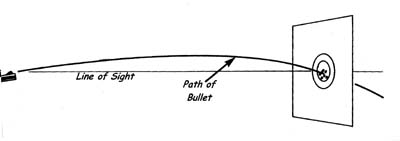Current Location: Home : Firearms : Juuhoukata Chap. 2-6
Interior ballistics is a subject of great concern to the reloader; as his trade deals with the effects of different powders, cases, bullets, and primers on the pressures produced inside the gun. Exterior ballistics is everyone's concern.
The below figure shows the path of a bullet once it leaves the barrel. The cant of the gun is greatly exaggerated to show the dynamics of what's happening. Most ballistics tables show the curve of a bullet in flight as an arch, leading to the erronous assumption that bullets rise as they leave a perfectly horizontal barrel. Physics dictates that this is impossible; a decellerating projectile always falls towards the ground as it travels horizontally. The bullet travels upwards because even if you are aiming horizontally level at a target, the barrel is canted slightly upwards. You are actually lobbing the bullet at the target. Ideally, the arced path of the bullet will intersect the aiming line of your eye with the sights at the target.

There are a number of forces acting on the bullet in flight- resistance of the air it passes through, varied by temperature, pressure, humidity, and winds; gravity, of course; anything else the bullet has to pass through to get to the target. The shape, size, and material of the bullet affects it's flight as well; but these effects are negligable at handgun combat shooting ranges. They become critical when one starts shooting rifles long distances.